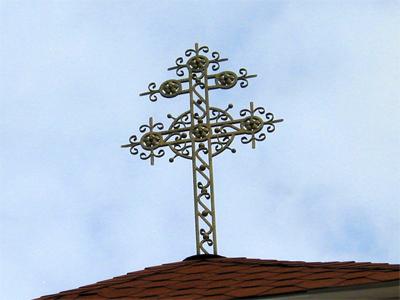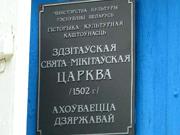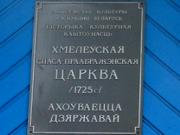Holy Fire route: spiritual and Orthodox heritage of the district.
“Tourist routes of the ∆аб≥нка¢скага district - УЎЋя’јћ ≤≈–”—јЋ≤ћ— ј√ј ј√ЌёФ
The route includes: ∆аб≥нка, Ѕулькова, јз¤ты, „ыжэ¢шчына, «дз≥тава, ¬¤л≥к≥¤ —¤хнов≥чы, ћац≥ев≥чы, ¬ежк≥, јрэп≥чы, —ц¤панк≥ and ’мелева.

On 1 September 2005 the inhabitants of the ∆аб≥нка¢ region witnessed an extraordinary event: for the first time on our land a flame appeared, kindled from a lamp brought from Jerusalem and from the Holy Sepulchre. This noble action took place on the eve of the Day of Belarusian Written Language and Printing, which that year was held in the ancient town of ам¤нцы.
The Orthodox churches of the ∆аб≥нка¢ area — Покроўская and ’мелеўская — became at that time the centres of the festive services. From here the grateful flame brought from the holy places was handed over to all the churches of the district. Along this route the traveller-pilgrim can make a pilgrimage to the sacred sites of the ∆аб≥нка¢ region.
The journey begins from the dean’s Pokrovskaya church in ∆аб≥нцы, which among the people is still called the “клішчыцкі” temple. The parish church, built in 1885 in the neoclassical style, has since become the centre of the ∆аб≥нка deanery. In general, although ∆аб≥нка is a relatively small town, today it functions as a centre for all Christian denominations: in addition to the Orthodox church, the Catholic Church of St. Joseph and a Protestant assembly are also located there.

From the district centre the traveller’s route following the traces of the Jerusalem flame lies to one of the oldest — not only in the ∆аб≥нка¢ district but in the whole of the Brest region — wooden churches in the village «дз≥тава. This wondrous and modest monument of Polesian carpentry this year marks its 505th anniversary since foundation.
Other churches encountered on the route are much younger in terms of foundation, yet they do not lose their distinctiveness for that. In 1885, simultaneously with the Orthodox church in Жабінка¢, the masonry Assumption church in the village Ѕулькова was built. It, like the Мікалаеўская church in јз¤ты (1867), belongs to examples of non-Russian architectural style. After visiting јз¤ты the traveller would do well to see the stone Ryzhe¢shchynskaya Vladimir church, sometimes called locally “У рупчыцкай” or “У—увора¢скай”. This church, built in 1891–1894 to designs by St. Petersburg architects Сенуа and Дубер, commemorates the battle on the Рупчыцкія fields. Our historical localities tell much about the famous pages of national and world history.
Much older is the Мікалаеўская church in ¬¤л≥к≥х — ¤хнов≥чах, erected in 1727 on the site of an earlier temple. This modest monument of Belarusian Polesia carpentry has great historical importance, since it was established through the care of the famous family of касцюшка¢-—¤хнов≥цк≥х. In ћац≥ев≥чы there is another касцюшка¢ family church and the Іаана¢ская church, built in 1718.
From here a pilgrim can proceed to the outskirts and to the village ¬ежк≥, where between 1990 and 1997 a beautiful brick Uspenskaya church was rebuilt and consecrated on 7 November 1997 by Metropolitan ‘≥ларэт. The new church rises, like a fabulous phoenix, on the site of the old wooden building destroyed by merciless fire during the Great Patriotic War.
Further, the path of the Jerusalem flame will certainly lead a history enthusiast to the Покроўская church which has been operating since 1721 in the village јрэп≥чы. Many well-known people who brought renown to our land originated from here; many of them were once baptised in the јрэп≥цкі church.

Even greater antiquity and unusual form distinguish the Міхайлаўская church in —ц¤панкі. Art historians and architects usually emphasise that this sacred building, erected in 1619, is one of the most characteristic examples of the interpretation of a stone basilica temple in wooden craftsmanship.
A fitting conclusion to the journey is a visit to the Transfiguration church (1725) and to the men’s Orthodox monastery located in the village ’мелева. This church and the miraculous icon of Our Lady of Ostra Brama, known far beyond our region, attract many pilgrims from different corners of the country and the world seeking faith and spiritual purification through repentance.